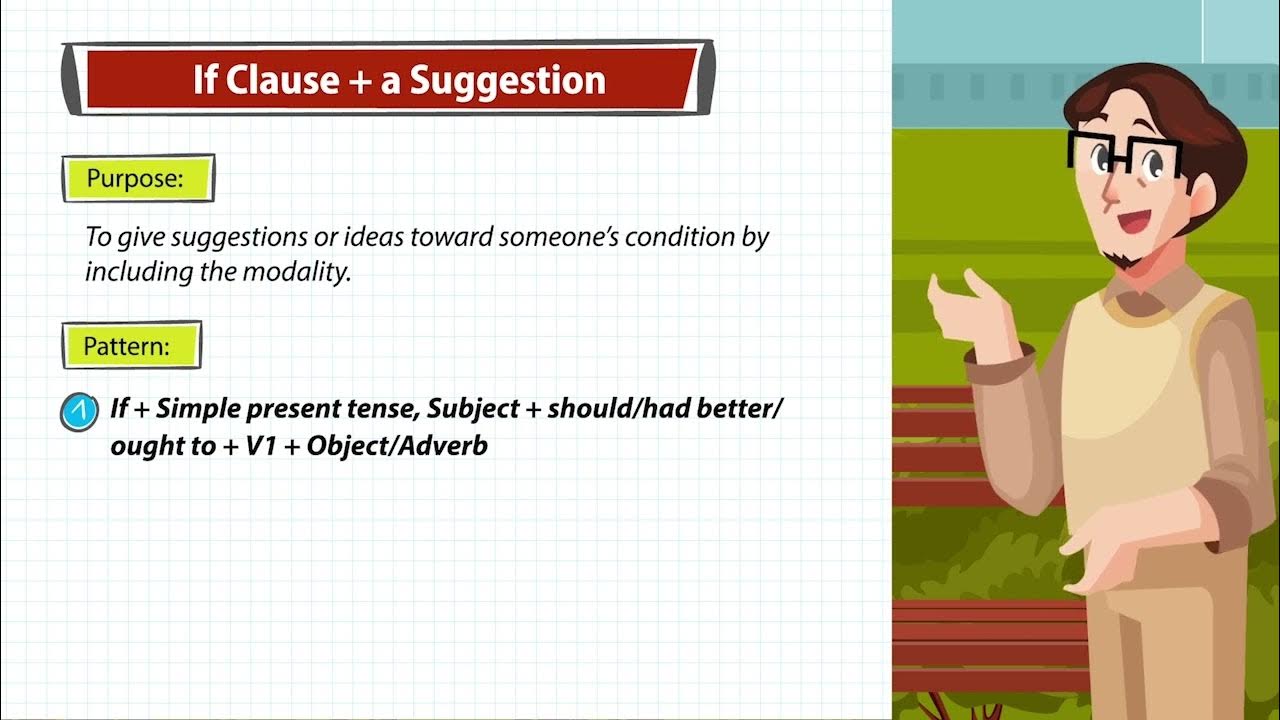BAHASA INGGRIS Kelas 12 - If Clause & If Conditional | GIA Academy
Summary
TLDRThis educational video script from GYA Academy's YouTube channel introduces and explains the use of 'if' conditional sentences in English. It covers the five functions of 'if' clauses, including giving commands, suggestions, stating facts, reminders, and expressing dreams or hopes. The script also delves into the three types of conditional sentences, providing examples and exercises to help viewers understand the structure and usage. The video aims to clarify the differences between the types and enhance learners' comprehension of conditional sentences.
Takeaways
- 😀 The video is from GYA Academy's YouTube channel, discussing conditional sentences in English.
- 🎓 The story of Agi is used as an example to explain the use of conditional sentences, involving a study tour to Korea.
- 🏆 Agi's parents promised to allow her to go on the study tour if she wins first place, illustrating a real-life application of conditional sentences.
- 🔍 The video explains 'if clauses' and their functions in forming conditional sentences, emphasizing their importance in English communication.
- 📚 There are five main functions of 'if clauses' discussed: giving orders, making suggestions, stating facts, reminders, and expressing dreams or hopes.
- 📝 The video provides patterns and examples for each function, such as 'If you have time, call me soon' for giving orders.
- 🤔 The difference between 'if clause + imperative' and 'if clause + subject + would/had better' is clarified through examples and exercises.
- 🧐 The video introduces three types of conditional sentences, each with its structure and usage, helping viewers understand hypothetical situations.
- 📈 Type 1 conditionals are for unreal situations that might happen in the future, using 'if + simple present' and 'subject + will + verb'.
- 🤷♂️ Type 2 conditionals are for impossible or contrary-to-fact situations, using 'if + simple past' and 'subject + would + verb'.
- 🕒 Type 3 conditionals imagine past situations and their outcomes, using 'if + past perfect' and 'subject + would + have + verb'.
- 📝 The video concludes with exercises to test understanding, encouraging viewers to apply what they've learned about conditional sentences.
Q & A
What is the main topic discussed in the video script?
-The main topic discussed in the video script is the use and types of conditional sentences in English, specifically focusing on 'if' clauses and their functions.
What are the five functions of 'if' clauses mentioned in the script?
-The five functions of 'if' clauses mentioned are: 1) Giving instructions or commands, 2) Giving suggestions, 3) Stating general facts, 4) Providing reminders, and 5) Expressing dreams or hopes.
Can you provide an example of an 'if' clause used for giving instructions?
-An example of an 'if' clause used for giving instructions is 'If you have time, call me soon.'
What is the pattern used for 'if' clause + imperative sentences?
-The pattern used for 'if' clause + imperative sentences is 'If + simple present + imperative.'
How is the 'if' clause used for giving suggestions structured?
-The 'if' clause for giving suggestions is structured as 'If + simple present + subject + would/should/could + base form of the verb.'
What are the three types of conditional sentences discussed in the script?
-The three types of conditional sentences discussed are: Type 1 (for hypothetical situations in the future), Type 2 (for situations that are unlikely or contrary to fact), and Type 3 (for situations that did not happen in the past and imagining the outcome of such situations).
What is the structure of a Type 1 conditional sentence?
-The structure of a Type 1 conditional sentence is 'if + simple present + subject + will + base form of the verb.'
How is a Type 2 conditional sentence structured?
-A Type 2 conditional sentence is structured as 'if + simple past + subject + would + base form of the verb.
What is the structure of a Type 3 conditional sentence?
-The structure of a Type 3 conditional sentence is 'if + past perfect + subject + would + have + past participle of the verb.
What is the story about Agi mentioned in the script?
-The story about Agi is that her parents promised to allow her to go on a study tour to Korea if she could win first place.
What is the purpose of the exercises provided in the script?
-The purpose of the exercises is to help viewers understand and differentiate between the different types of conditional sentences and their usage.
Outlines

This section is available to paid users only. Please upgrade to access this part.
Upgrade NowMindmap

This section is available to paid users only. Please upgrade to access this part.
Upgrade NowKeywords

This section is available to paid users only. Please upgrade to access this part.
Upgrade NowHighlights

This section is available to paid users only. Please upgrade to access this part.
Upgrade NowTranscripts

This section is available to paid users only. Please upgrade to access this part.
Upgrade NowBrowse More Related Video

CONDITIONAL SENTENCE - BAHASA INGGRIS SMA

Zero Conditional En Ingles - Oraciones Con Cero (0) Condicional - Negativas Interrogativas

BAHASA INGGRIS Kelas 10 - Descriptive Text | GIA Academy

BIOLOGI SMA Kelas 10 - Virus | GIA Academy

IF CONDITIONAL WITH IMPERATIVES

27) YDT - Conditionals In English 2 - Osman Yunus ÖZER - 2025
5.0 / 5 (0 votes)